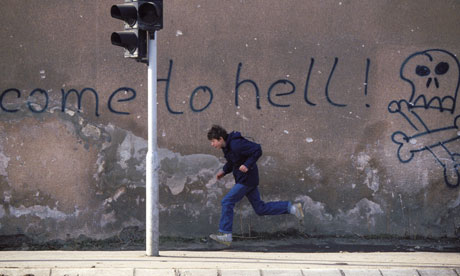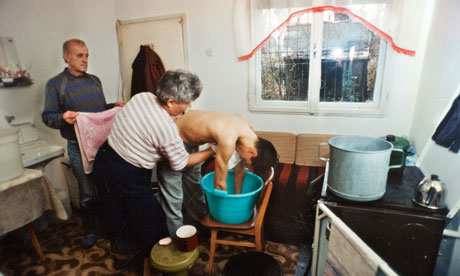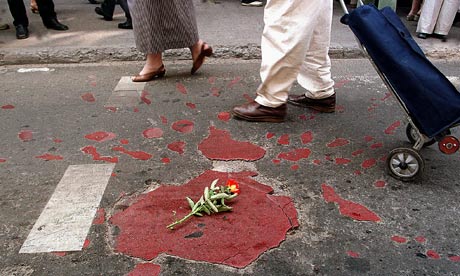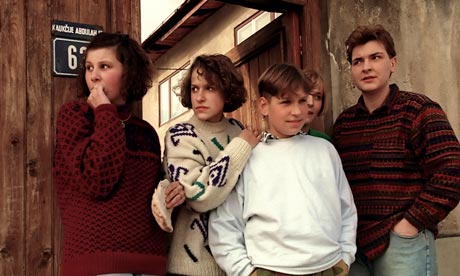TS
kolonel.bejo
(Sniper Alley) Life and death on my street in Sarajevo
For two years, Barbara Demick chronicled the trials of one Sarajevo street during the Serbian siege. In her latest book, Besieged: Life Under Fire on a Sarajevo Street, she catches up with the people she befriended

A boy running the gauntlet along a Sarajevo street during the siege in February 1993. Photograph: Laurent Van Der Stockt/Gamma-Rapho via Getty Images
In 1991, the year that the Soviet Union broke up, a nationalist revival was sweeping eastern Europe. It found its most pernicious expression in Yugoslavia, a country patched together in 1943 out of six republics. Slovenia, the richest and most westernised, extricated itself after only a 10-day war. Croatia's war was longer and deadlier. The Yugoslav National Army, dominated by Serbs, put up more of a fight to hold on to the boomerang-shaped republic that included most of the Adriatic coastline.

The savagery reached its height the following year when Bosnia declared its independence from the country that had been collapsing around it. Bosnia was the most ethnically diverse of the republics and its leaders proposed that it would be in effect a mini-Yugoslavia of Serbs, Croats and Muslims living together. Nationalists in the Serb population wanted to remain with Serbia and formed a breakaway republic, the Republika Srpska. With the tacit support of Serbian president Slobodan Miloševic, they commandeered much of the weaponry of the disbanding Yugoslav National Army and launched a campaign to erase the Muslim presence on the lands they claimed for their own. Concentration camps and mass graves returned to Europe for the first time since the second world war. The beautiful city of Sarajevo, with its mosques, synagogues, Orthodox and Catholic churches, was besieged for three and a half years from April 1992, its food and electricity supplies cut off, its civilian population relentlessly bombarded.
A whole generation of war correspondents cut their teeth covering Bosnia. It was so difficult to get in and out of Sarajevo that a huge press corps simply moved into the Holiday Inn and became part of the story; I experienced the siege with the Sarajevans. True, we had electricity, some food and occasional running water and many of us drove around in armoured cars, but we were as vulnerable as anybody to the constant mortar fire.
From the outside, the conflict seemed very complicated – ancient Balkan hatreds, geopolitical fault lines – but when you were actually there, it was simple. Civilians were trapped inside the city; people with guns were shooting at them – and us. The Sarajevans were impressive. Well into the war, when idealism should have been shattered, most Sarajevans still believed they could preserve a multicultural space in their city.
When I arrived in January 1994, an "empathy fatigue", as they called it in the humanitarian aid business, had settled over Bosnia. Readers around the world were numbed to the suffering of a people whose names they couldn't pronounce in a place they had never been. To bring home the reality of the war, my editors at the Philadelphia Inquirer suggested I pick a street in Sarajevo and profile the people living there, describing their lives.

Barbara Demick at work in the Holiday Inn, Sarajevo, 1994. Photograph: John Costello
I knew the street I wanted to write about the first time I walked up it. Even battered by war, it was a beautiful street, rising uphill at a perfect perpendicular angle from the main thoroughfare, three white minarets piercing the sky above red rooftops. I spent the better part of two years on Logavina Street, knocking on doors, drinking coffee from people who could barely afford it, hearing their tragedies. Their stories formed the basis of a series of articles and later were woven into a book. In early 1995, after a ceasefire made the city a little safer, I moved out of the Holiday Inn into a flat around the corner from Logavina; later, I rented a room in the house of the first couple I had met, Jela and Zijo Džino.
The war ended in 1995. After more than 100,000 deaths and a massacre in which 8,000 unarmed Muslim men were murdered in the town of Srebrenica, Nato finally intervened in August with air strikes against the Serbs. Today, all six republics are individual countries – Serbia, Croatia, Macedonia, Montenegro and Slovenia, as well as Bosnia, although Bosnia is partitioned into separate republics for Serbs, and for Croats and Muslims. Kosovo, which is largely Albanian, broke off in 2008, although Serbia has not recognised its independence. The region is more or less at peace, with the exception of occasional skirmishes in Kosovo, where international peacekeepers are still present.
Since the 90s I have been back to Sarajevo twice, once in 2007 and more recently in 2011. Each time, I was struck by how much it looked and felt the same. The city is timeless, almost immutable. Along the stone alleys of the Bašcaršija, the jewellers are tapping away behind shopfronts with the same names: Kasumagic, Cengic. Even the music is the same 1980s technopop.
So little has changed on Logavina Street that I can almost navigate my way with my eyes closed. At the foot of the street, there's the Caffe Elvis. Overhead, a messy cat's cradle of electric wires. In front of the mosque on the first corner is a pack of half a dozen of the same dun-coloured stray dogs, or perhaps their descendants, glaring at me through half-closed eyes.
From the outside the grocery doesn't look much different from the days when it distributed humanitarian aid. Underneath a car parked on the pavement, I can see where the tarmac was gouged out by a mortar shell, the shrapnel splashing out in a circular pattern from the point of impact. A civic group that started up in the mid-90s poured red resin into the indentations to make them into a memorial – they call them "Sarajevo roses", though I think "pawprints", the old name we used during the war, is truer to their appearance.
Jela and Zijo Džino are the people on Logavina Street with whom I have stayed most closely in touch. Zijo is a Muslim from an old Sarajevo family that had lived in the same house for two centuries. Jela is a Catholic from Šibenik, on the Croatian coast. They met in 1956 when Zijo was on holiday at a seaside motel. Jela was working there as a waitress. He thought she looked like an actress. She thought he was too skinny, and brought him extra portions of dinner. When they married, nobody in their respective families raised objections about religious differences between the two.
Their house is far from the grandest on the street, though it is painted in a confident fin-de-siècle pink. Despite their advancing years, they have kept up the garden that sustained them through the war. Onions, chard, beans and squash are planted in tidy rows, although the flowers are wild, a profusion of blue hydrangeas and yellow rhododendron.

Jela and Zijo Dzino during the siege in 1995, washing their ill son Nermin. Photograph: John Costello
During the war, Jela and Zijo spent most of their time in the small kitchen downstairs because it was safer; now it is more convenient because it saves Jela the trouble of climbing the stairs. She has pain where her left leg was injured by a mortar shell and she is broader in the hips than before. Zijo is sprightly, but while he keeps his weight low and doesn't smoke, he has had a heart attack and his overall health isn't as good as his wife's.
Although I have forgotten most of what little Serbo-Croatian I knew, it is easy to understand them because the refrain is the same as during the war. "Nema ništa" – "There's nothing". Jela takes a drag of her cigarette, now a fancy-looking new brand called Aura instead of her old Drinas. "The economy collapsed during the war and it continues to go down."
The Džinos live on modest pensions from the state-owned factories where they worked before retiring. Jela's textile factory and Zijo's housewares company both closed down after the war. To the extent that new businesses have come in, they're small – cafés, boutiques. The timeless quality about Sarajevo that I selfishly find so appealing, Jela points out, is the mark of a failed economy.
Only because they were sent money by their daughter Alma, a psychiatrist living in South Africa, were they able to patch over the hole where the mortar shell slammed into their kitchen. Many of their neighbours' houses still have war damage for lack of money for repairs.
The statistics bear out what Jela is saying. Salaries in Bosnia are among the lowest in Europe, between €300 to €400 (£250-£330) a month, and unemployment about the highest, 46%. The World Bank, in its annual Ease of Doing Business Index, ranked Bosnia and Herzegovnia 110th out of 187 countries in 2010, the lowest of the six former republics of Yugoslavia. One reason is the Rube Goldbergian political system set up by the Dayton peace accord. In order to keep the Bosnian-Croat Federation and 10 separate cantons (they were apparently aspiring to Switzerland when they picked the term) and a separate government for the small city of Brcko that nobody could agree on, the pact created 14 separate governments. "It is the most complicated political system I have ever seen," a US official told me. "You need to have something like 50 documents to open any kind of business."
The Džinos's son Nermin, although he speaks fluent English as a result of a stint living with his sister, could only get a job when he returned as a driver for the state court. It pays so poorly that he can barely support his partner and their infant son. "I make in a month what my sister makes in a week," Nermin complains.
The following weekend I finally get to meet Alma, who is visiting with her husband Siniša and two daughters. If anything, Alma seems more traumatised by the war than her battle-scarred parents or veteran brother. This is something I notice in many people I meet. For those who drop in every year or so, everything reminds them of the war that they missed and the experience feels fresher and more vivid. Alma left Sarajevo on Saturday 4 April 1992. Two weeks later, she was in Belgrade watching Serbian TV when she saw a report from the city. "There was this house with a hole in it. And I thought: 'Oh my God, that's my parents' house.' I called my mother-in-law and she said, 'No, I'm sure you're wrong.' Then I saw shots from the hospital. There was my father, naked, with a sheet over his genitals."

A 'Sarajevo rose', the red resin filling in the holes left by a mortar blast. Photograph: Reuters
We have got far enough into the conversation without talking about ethnicity, which hangs like a foul miasma, low over Sarajevo. You might not notice it immediately and once you're in Sarajevo a while, you may forget it at times, but questions about who is Serb, Croat or Muslim lurk in the background. People avoid talking about ethnicity. They steer the conversation away. Or else they speak with excruciating political correctness, using so much euphemism it is hard to grasp their intent. You don't say Bosnian Muslim any more; you say Bosniak (a cumbersome word we journalists ridiculed during the war). You say "Bosnian of Serbian nationality" for a Serb who still lives in Sarajevo, or "Serb aggressor" for somebody who fought on the other side.
Alma is a direct person, so she plunges into the subject. Siniša is a Serb – at least he identifies himself as such, although his mother is Catholic. Although he wasn't one of the Serbs who went over to the other side, he didn't stay and help either. Six weeks after Alma left, he managed to sneak out of the city by slipping into a convoy of departing Yugoslav National Army vehicles. "He never did anything bad. His name is still clean. Everybody likes him," says Alma. "We had friends who left because they went over to the Serb side of Sarajevo. As long as they didn't do any harm, it is OK."
Yet the ethnic question isn't dismissed so easily. Everybody knows who's who. Both Alma and Siniša worry about the influence of Wahhabism, the Sunni fundamentalist doctrine from Saudi Arabia. "Now everybody is so preoccupied with religion. They are supposed to invest in industry. Instead they are building mosques," he says.
Just how many Serbs still live in Sarajevo? Bosnia hasn't done a census since 1991, so nobody quite knows or is even willing to hazard a guess, although it is assumed the number is a fraction of the pre-war population of 157,000. Logavina Street's Serb population has been reduced as much by old age as ethnic tension. Many of the Sarajevo Serbs have moved out of the centre of the city to Pale, the skiing village that was Radovan Karadžic's headquarters during the war, and to other Sarajevo neighbourhoods that have been assigned to Republika Srpska.
The whole area is now called "Eastern Sarajevo". Many of the Serbs who work in government jobs in central Sarajevo feel more comfortable living in Republika Srpska and so they commute back and forth. The licence plates are the same on both sides; in a brilliant bit of Balkan diplomacy, they use the letters T, K, J, O and A – which happen to be the same in the Cyrillic and Latin alphabets – so that nobody knows who's who from their car.
Ethnic tension is especially pronounced in the workplace, where jobs are often allocated by nationality. The system had its genesis in Communist times and was reinstated after the war in a misguided attempt to achieve ethnic balance. In the Dayton peace accord, it applied to elected political offices, namely the tripartite presidency in which a Muslim, a Serb and a Croat share power. It has been expanded since to include military, police and other civil service jobs. Departments have to be filled with "x" number of Muslims, "y" number of Croats, "z" number of Serbs. Known as the "national key", the system is dysfunctional and discriminatory, widely ridiculed and subject to legal challenges.
In 1990, before the break-up of Yugoslavia, 13% of marriages were mixed, and in Sarajevo the figure was above 30%. The Džinos's son Nermin is among those who refused to be categorised. Rather than choose between his Muslim father and Catholic mother, he listed himself as "other". He and his girlfriend, also mixed, picked the name Darian for their infant son, which isn't associated with any of the three ethnic groups.
Others pick an identity for pragmatic reasons rather than religious. There are never quite enough Serbs and Croats to fill the positions since the quotas are based on a census taken in 1991, back when Muslims were only 50% of the population. If you're a half-Muslim, do you declare yourself Muslim to enjoy the confidence of being in the majority, or do you chose to be a minority, a Serb or a Croat, for the positive discrimination that will help you get a job? And, of course, the preference for Serbs and Croats builds ethnic resentment.
"When they open a new job and a Bosnian Croat or Bosnian Serb gets it, you can overhear people talking about it. They'll say: 'Do you see that guy? He's a Serb'," says Nermin.
On bad days during the siege of Sarajevo, as many as 3,500 shells rained down on the city. You could duck snipers by staying away from exposed junctions, but no one could predict where a shell might land. At the upper end of Logavina Street, a bomb shelter was set up in a former orphanage, a place bleaker than anything imagined by Charles Dickens. The walls were a sallow, institutional green and seemed to exude a century's misery.
The building was perched – haunted-house style – atop a ridge, above a weed-strewn vacant lot. So little daylight penetrated the dank halls that you needed to navigate by torchlight, even on the sunniest days. Built in the 1890s, the orphanage housed refugees during both world wars. It briefly functioned as a jail. Many Logavina residents thought the building was cursed with bad karma and would not go near it.

Delila Lacevic (at left) with her cousins during the siege of Sarajevo, flinching at the sound of a nearby explosion. Photograph: John Costello/Granta
Delila Lacevic, then 19 years old, lived next door to the orphanage with her grandmother in an old family house. During the first winter of the war, she and her 11-year-old brother Berin and their parents had all gone together to a brewery across the river that was one of the only places during the siege that had water. As they waited their turn, mortar shells came slamming into a brick wall above them. Delila grabbed her brother and fell to the ground. When the whirlwind of brick and shrapnel stopped, they looked for their parents.
"Are Mummy and Daddy OK?" Berin asked.
"Can't you see they're dead? Daddy has no head," Delila snapped back.
Eight people were killed at the brewery on 15 January 1993. Footage of the shelling, and of Berin at his parents' funeral, was broadcast around the world. A retired couple in Kansas saw it on television and vowed they would evacuate the orphaned boy from Sarajevo. They didn't realise at the time that Berin had a sister. Delila was badly injured herself in the shelling and was in the hospital during the funeral. After Berin arrived in the US, they vowed to rectify their mistake and bring out Delila as well. When I met her in 1994, she was curled up inside the house with her brother's cat, studying English in anticipation of her new life. She told me once she left Sarajevo, she would never return. In fact, she came back only once, in 2007, to show her American husband and mother-in-law around Sarajevo. They were supposed to stay for two weeks. They left after five days.
She couldn't even take the sight of the gravestone she and Berin had purchased for their parents – topped with a Turkish fez in the traditional Bosnian Muslim style. After a decade without cigarettes, she started chain-smoking again. "I can't forget. I can't forgive. I can't get over it. I don't want to stare at it," Delila told me about her trip. She didn't want to hang around Sarajevo feeling sorry for herself. "Shit happens. Kids in Srebrenica are still waiting for their dads' body parts. At least I know where my parents are buried."
http://www.theguardian.com/books/201...th-in-sarajevo
++++++++++++++++++++++++++++++++++++++++++++++++++++++++++++
The city during the siege was an indescribably surreal place," said Jim. "It really was a living nightmare - hundreds and even thousands of shells would land within the besieged areas of the city in a single day. The sniping would be incessant."
"Literally nowhere in the city was safe from the constant assault. Civilians were killed or injured on their balconies, in their beds, on buses, in hospital wards, at funerals and, especially, whilst running or cycling through the streets."
From 1992 to 1996 Sarajevo's population of just over 500,000 people suffered shelling, tank fire and sniper attacks by 18,000 Serbian soldiers when they tried to break-away from Yugoslavia. Over 11,000 people lost their lives, and large parts of the city were destroyed.
Diubah oleh kolonel.bejo 31-10-2014 09:32
0
14.6K
20
Thread Digembok
Urutan
Terbaru
Terlama
Thread Digembok
Komunitas Pilihan